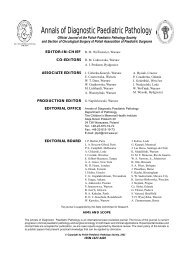annals 1-2.qxd - Centrum Zdrowia Dziecka
annals 1-2.qxd - Centrum Zdrowia Dziecka
annals 1-2.qxd - Centrum Zdrowia Dziecka
Create successful ePaper yourself
Turn your PDF publications into a flip-book with our unique Google optimized e-Paper software.
38<br />
Patients, material and methods<br />
The Children's Memorial Health Institute is the referral hospital<br />
for children with biliary atresia. From children hospitalized<br />
between May 1991 and April 2001 who underwent<br />
Kasai hepatoportoenterostomy at age between 30 and 70<br />
days (average 55 days) we distinguished two groups according<br />
to clinical outcome after operation: 12 liver biopsy<br />
specimens were qualified to the first – unfavorable group<br />
with poor prognosis, because patients, 16% male and 74%<br />
female, died or needed liver transplantation within 2 years<br />
after Kasai procedure (Table 1A) and 17 other liver biopsy<br />
specimens were qualified to the second – favorable group<br />
with good prognosis, because patients, 23% male and 77%<br />
female, survived over 5 years with no complications (Table<br />
1B). The liver wedge biopsies were collected during<br />
Kasai procedure. The research was carried out in accordance<br />
with the recommendations of the Bioethic Commission<br />
in the hospital.<br />
Histological examination<br />
All liver biopsy specimens were fixed in 10% neutral buffered<br />
formalin and embedded in paraffin. Sections displaying<br />
at least 10 portal tracts were routinely stained by Hematoxylin-Eosin,<br />
Periodic Acid-Schiff method, with and without<br />
diastase, Gomori silver stain, Azan method. In the course of<br />
evaluation histological activity of the disease, each sample<br />
was described using Ludwig classification for fibrosis and inflammation<br />
[2]. Liver fibrosis was assessed as follows: grade<br />
1 mild fibrosis: expansion of fibrous tissue in the portal<br />
tract; grade 2 moderate fibrosis with portal to portal bridging;<br />
grade 3 severe fibrosis with portal to portal bridging; grade<br />
4 cirrhosis with a reconstruction of hepatic lobules. Inflammatory<br />
changes were classified as grade 1 minimal inflammation;<br />
grade 2 mild inflammation; grade 3 moderate inflammation;<br />
grade 4 severe inflammation. The following categories<br />
of lesions were investigated: piecemeal necrosis,<br />
lobular inflammation, microabscesses, focal necrosis, portal<br />
and lobular inflammation, giant cell transformation, cholestasis,<br />
cholangitis, bile duct dilatation, cholangiolitis. These<br />
histological criteria were assessed as follows [7] – grade<br />
0 absent; 1 minimally present; 2 moderately present; 3 severe<br />
present.<br />
Immunohistochemical study<br />
The ductal and ductular phenotype was examined on paraffin<br />
embedded tissue using monoclonal antibodies directed<br />
against Cytokeratin 7 (OV-TL 1:50 Dako) and 19 (RCK 108<br />
1:100 Dako) and SMA by means of EnVision system<br />
DAKO. This method allowed to determine changes specific<br />
for ductal plate malformation by the positive staining on bile<br />
ductules epithelia and abnormal ductal structures. Immunologic<br />
staining for SMA was performed by an immunoperoxidase<br />
method allowed to demonstrate the lobular and portal<br />
architecture of the liver. One negative control was used<br />
from the liver tissue obtained from a child with autoimmune<br />
hepatitis.<br />
Table 1<br />
Characteristics of patients<br />
A. Group I: The first unfavorable group, patients died<br />
or needed liver transplantation within 2 years after Kasai<br />
procedure<br />
No patients Age at Kasai Survival/LTx<br />
procedure (days) (ages)<br />
1 F 50 0,4<br />
2 M 64 0,6<br />
3 M 60 0,6<br />
4 F 68 0,7<br />
5 F 49 0,7<br />
6 F 60 0,7<br />
7 F 46 0,9<br />
8 F 68 1,1<br />
9 F 55 1,2<br />
10 F 39 1,8<br />
11 F 47 2,7<br />
12 F 31 4,0<br />
B. Group II: The second favorable group, patients survived<br />
over 5 years with native liver after Kasai procedure<br />
No patients Age at Kasai Survival/LTx<br />
procedure (days) (ages)<br />
1 M 52 5,7<br />
2 M 60 6,1<br />
3 F 61 6,1<br />
4 F 48 6,2<br />
5 F 68 6,3<br />
6 F 38 8,1<br />
7 F 42 8,4<br />
8 F 63 8,8<br />
9 F 63 10,0<br />
10 F 55 10,0<br />
11 F 65 10,3<br />
12 M 63 11,0<br />
13 F 39 11,6<br />
14 F 48 12,0<br />
15 F 55 12,7<br />
16 F 69 16,9<br />
17 M 58 17,9<br />
Statistical analysis<br />
Chi-square Independence test and Kolmogorov-Smirnov test<br />
(significance level 0,05) was applied for the purpose of comparison<br />
the various histopathological intrahepatic changes<br />
with the age at Kasai procedure and length of survival period<br />
or time to the liver transplantation after operation.

















